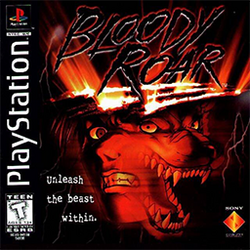Bloody Roar (video game)
| Bloody Roar | |
|---|---|

PlayStation cover art
|
|
| Developer(s) |
Raizing (arcade) Hudson Soft (PlayStation) |
| Publisher(s) | Sony Computer Entertainment |
| Distributor(s) | Sony Computer Entertainment |
| Director(s) | Kenji Fukuya Susumu Hibi |
| Producer(s) | Haruhiko Ikeda Masato Toyoshima |
| Designer(s) | Shinichi Ōnishi |
| Programmer(s) | Yuichi Ochiai |
| Artist(s) | Mitsuakira Tatsuta Shinsuke Yamakawa |
| Composer(s) |
Atsuhiro Motoyama Manabu Namiki Kenichi Koyano Hitoshi Sakimoto Masaharu Iwata Tomoko Miyagi (arcade) Takayuki Negishi (PlayStation) |
| Series | Bloody Roar |
| Platform(s) | Arcade, PlayStation |
| Release date(s) |
Arcade
|
| Genre(s) | Fighting |
| Mode(s) | Single player, multiplayer |
| Cabinet | Horizontal |
| CPU | SPU |
| Sound | Sound CPU : 68000 Sound Chips : SPU, YMF271 |
| Display | Raster, 640 x 480 pixels, 65536 colors |
| Aggregate score | |
|---|---|
| Aggregator | Score |
| GameRankings | 78% |
| Review scores | |
| Publication | Score |
| EGM | 7.75/10 |
| GamePro | 5/5 |
| GameSpot | 7.7/10 |
| IGN | 8/10 |
| OPM (US) | 3.5/5 |
| PSM | 4/5 |
Bloody Roar, known as Bloody Roar: Hyper Beast Duel in Europe and Japan, is a fighting video game originally developed by Raizing (now Eighting) as an arcade game. It was later adapted for the PlayStation by Hudson Soft and published by Sony Computer Entertainment for the PlayStation. The arcade version was released on July 7, 1997 and was titled Beastorizer in North America. The PlayStation version was released in Japan on November 6, 1997, in North America (under the title Bloody Roar) on October 31, 1997 and in Europe on March 1998.
Bloody Roar is the first game in the Bloody Roar video game series and was followed by four sequels on multiple platforms. The game's story centers on a group of warriors known as "zoanthropes", who have the power to transform into half-human half-animal "Beasts", and the Tylon Corporation, an underground organization that seeks to use zoanthropes as mind-controlled weapons. The game received generally positive reviews from critics for its originality and graphics, while the audio received mixed opinions. The game's success resulted in its re-release for The Best range on October 14, 1999. The game was re-released on the PlayStation Network in North America on August 20, 2009.
At the beginning of each stage, both players have a set amount of energy that is used to activate "Beast Mode", which causes the character to change into a Beast. Players may transform at any time after the letter "B" appears in the "Beast Indicator" below the players' life energy indicators. The Beast Indicator appears blue when storing the energy needed for transforming. When the Beast Indicator is fully charged, the word "BEAST" appears, and the player can activate Beast Mode by pressing a certain button. During Beast Mode, the amount of fighting moves available to the character increases, the character becomes heavier, 3% of the character's life energy recovers and the character's jumping ability increases. While in Beast Mode, the Beast Indicator turns yellow. The yellow area decreases according to damage sustained by the character. The yellow area does not recharge during the current round. When the yellow area completely depletes, the Beast Mode will negate when the character is hit by an effective technique from the opponent.
...
Wikipedia
